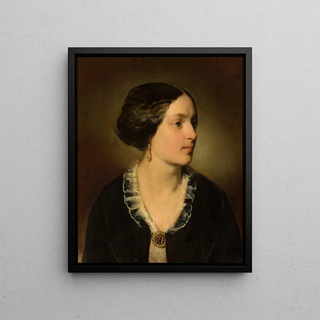Art print | Portrait of Katarzyna Potocka née Branicka 1825-1907 - Friedrich von Amerling


View from behind

Frame (optional)
In the world of art, some works transcend the simple frame to become timeless witnesses of history and culture. The "Art print of Katarzyna Potocka née Branicka" by Friedrich von Amerling, painted in 1825, is one of those creations that capture not only the essence of an individual but also the spirit of an era. This portrait, imbued with delicacy and sophistication, invites us to delve into the life of its model, a woman of great social and cultural significance in Poland. Through Amerling's brushstrokes, we discover an emblematic figure, whose grace and dignity are reflected in every detail of her face and posture.
Style and uniqueness of the work
Friedrich von Amerling's technical mastery is undeniable in this portrait. The artist, recognized for his skill in capturing the nuances of light and shadow, succeeds in giving life to Katarzyna Potocka with rare emotional depth. The subtle and harmonious color palette enhances the softness of her complexion while highlighting the details of her elegant dress. Every element of the painting, from the folds of her garment to the expression of her gaze, seems to tell a story— that of a strong and resilient woman. Amerling manages to create an intimate atmosphere, where the viewer is invited to contemplate not only the beauty of his subject but also her character and personal history. This art print is not limited to a simple representation; it becomes a true dialogue between the artist, the subject, and the audience.
The artist and his influence
Friedrich von Amerling, born in 1803 in Vienna, is one of the most renowned portraitists of his time. Trained in European artistic circles, he established himself thanks to his unique style, blending realism and romanticism. Amerling had the opportunity to paint many influential personalities of his era, which contributed to his fame. His approach to portraiture goes beyond mere physical representation; he seeks to capture the soul of his subjects, to reveal their personality through expressions

Matte finish

View from behind

Frame (optional)
In the world of art, some works transcend the simple frame to become timeless witnesses of history and culture. The "Art print of Katarzyna Potocka née Branicka" by Friedrich von Amerling, painted in 1825, is one of those creations that capture not only the essence of an individual but also the spirit of an era. This portrait, imbued with delicacy and sophistication, invites us to delve into the life of its model, a woman of great social and cultural significance in Poland. Through Amerling's brushstrokes, we discover an emblematic figure, whose grace and dignity are reflected in every detail of her face and posture.
Style and uniqueness of the work
Friedrich von Amerling's technical mastery is undeniable in this portrait. The artist, recognized for his skill in capturing the nuances of light and shadow, succeeds in giving life to Katarzyna Potocka with rare emotional depth. The subtle and harmonious color palette enhances the softness of her complexion while highlighting the details of her elegant dress. Every element of the painting, from the folds of her garment to the expression of her gaze, seems to tell a story— that of a strong and resilient woman. Amerling manages to create an intimate atmosphere, where the viewer is invited to contemplate not only the beauty of his subject but also her character and personal history. This art print is not limited to a simple representation; it becomes a true dialogue between the artist, the subject, and the audience.
The artist and his influence
Friedrich von Amerling, born in 1803 in Vienna, is one of the most renowned portraitists of his time. Trained in European artistic circles, he established himself thanks to his unique style, blending realism and romanticism. Amerling had the opportunity to paint many influential personalities of his era, which contributed to his fame. His approach to portraiture goes beyond mere physical representation; he seeks to capture the soul of his subjects, to reveal their personality through expressions






